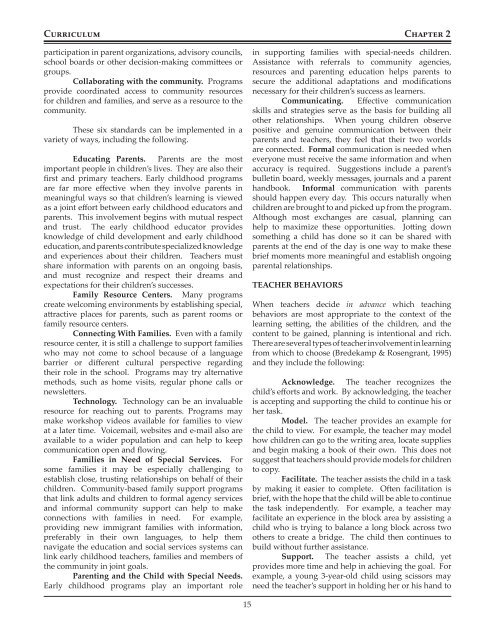Early Childhood
Early Childhood
Early Childhood
Create successful ePaper yourself
Turn your PDF publications into a flip-book with our unique Google optimized e-Paper software.
Curriculum Chapter 2<br />
participation in parent organizations, advisory councils,<br />
school boards or other decision-making committees or<br />
groups.<br />
Collaborating with the community. Programs<br />
provide coordinated access to community resources<br />
for children and families, and serve as a resource to the<br />
community.<br />
These six standards can be implemented in a<br />
variety of ways, including the following.<br />
Educating Parents. Parents are the most<br />
important people in children’s lives. They are also their<br />
first and primary teachers. <strong>Early</strong> childhood programs<br />
are far more effective when they involve parents in<br />
meaningful ways so that children’s learning is viewed<br />
as a joint effort between early childhood educators and<br />
parents. This involvement begins with mutual respect<br />
and trust. The early childhood educator provides<br />
knowledge of child development and early childhood<br />
education,andparentscontributespecializedknowledge<br />
and experiences about their children. Teachers must<br />
share information with parents on an ongoing basis,<br />
and must recognize and respect their dreams and<br />
expectations for their children’s successes.<br />
Family Resource Centers. Many programs<br />
create welcoming environments by establishing special,<br />
attractive places for parents, such as parent rooms or<br />
family resource centers.<br />
Connecting With Families. Even with a family<br />
resource center, it is still a challenge to support families<br />
who may not come to school because of a language<br />
barrier or different cultural perspective regarding<br />
their role in the school. Programs may try alternative<br />
methods, such as home visits, regular phone calls or<br />
newsletters.<br />
Technology. Technology can be an invaluable<br />
resource for reaching out to parents. Programs may<br />
make workshop videos available for families to view<br />
at a later time. Voicemail, websites and e-mail also are<br />
available to a wider population and can help to keep<br />
communication open and flowing.<br />
Families in Need of Special Services. For<br />
some families it may be especially challenging to<br />
establish close, trusting relationships on behalf of their<br />
children. Community-based family support programs<br />
that link adults and children to formal agency services<br />
and informal community support can help to make<br />
connections with families in need. For example,<br />
providing new immigrant families with information,<br />
preferably in their own languages, to help them<br />
navigate the education and social services systems can<br />
link early childhood teachers, families and members of<br />
the community in joint goals.<br />
Parenting and the Child with Special Needs.<br />
<strong>Early</strong> childhood programs play an important role<br />
15<br />
in supporting families with special-needs children.<br />
Assistance with referrals to community agencies,<br />
resources and parenting education helps parents to<br />
secure the additional adaptations and modifications<br />
necessary for their children’s success as learners.<br />
Communicating. Effective communication<br />
skills and strategies serve as the basis for building all<br />
other relationships. When young children observe<br />
positive and genuine communication between their<br />
parents and teachers, they feel that their two worlds<br />
are connected. Formal communication is needed when<br />
everyone must receive the same information and when<br />
accuracy is required. Suggestions include a parent’s<br />
bulletin board, weekly messages, journals and a parent<br />
handbook. Informal communication with parents<br />
should happen every day. This occurs naturally when<br />
children are brought to and picked up from the program.<br />
Although most exchanges are casual, planning can<br />
help to maximize these opportunities. Jotting down<br />
something a child has done so it can be shared with<br />
parents at the end of the day is one way to make these<br />
brief moments more meaningful and establish ongoing<br />
parental relationships.<br />
TEACHER BEHAVIORS<br />
When teachers decide in advance which teaching<br />
behaviors are most appropriate to the context of the<br />
learning setting, the abilities of the children, and the<br />
content to be gained, planning is intentional and rich.<br />
Thereareseveraltypesofteacherinvolvementinlearning<br />
from which to choose (Bredekamp & Rosengrant, 1995)<br />
and they include the following:<br />
Acknowledge. The teacher recognizes the<br />
child’s efforts and work. By acknowledging, the teacher<br />
is accepting and supporting the child to continue his or<br />
her task.<br />
Model. The teacher provides an example for<br />
the child to view. For example, the teacher may model<br />
how children can go to the writing area, locate supplies<br />
and begin making a book of their own. This does not<br />
suggest that teachers should provide models for children<br />
to copy.<br />
Facilitate. The teacher assists the child in a task<br />
by making it easier to complete. Often facilitation is<br />
brief, with the hope that the child will be able to continue<br />
the task independently. For example, a teacher may<br />
facilitate an experience in the block area by assisting a<br />
child who is trying to balance a long block across two<br />
others to create a bridge. The child then continues to<br />
build without further assistance.<br />
Support. The teacher assists a child, yet<br />
provides more time and help in achieving the goal. For<br />
example, a young 3-year-old child using scissors may<br />
need the teacher’s support in holding her or his hand to


